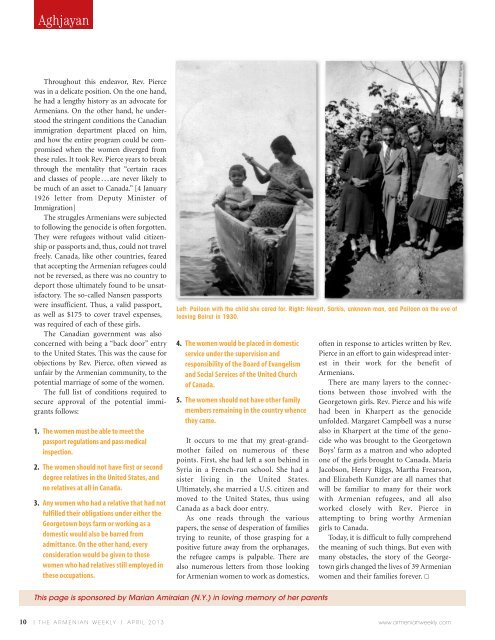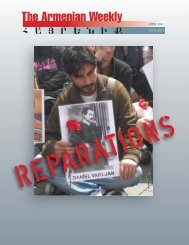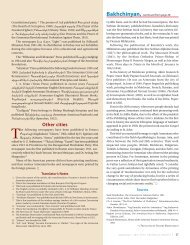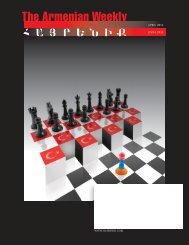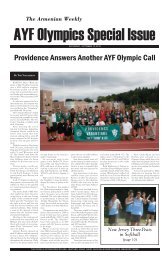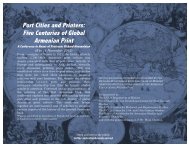You also want an ePaper? Increase the reach of your titles
YUMPU automatically turns print PDFs into web optimized ePapers that Google loves.
Aghjayan<br />
Throughout this endeavor, Rev. Pierce<br />
was in a delicate position. On the one hand,<br />
he had a lengthy history as an advocate for<br />
<strong>Armenian</strong>s. On the other hand, he understood<br />
the stringent conditions the Canadian<br />
immigration department placed on him,<br />
and how the entire program could be compromised<br />
when the women diverged from<br />
these rules. It took Rev. Pierce years to break<br />
through the mentality that “certain races<br />
and classes of people...are never likely to<br />
be much of an asset to Canada.” [4 January<br />
1926 letter from Deputy Minister of<br />
Immigration]<br />
The struggles <strong>Armenian</strong>s were subjected<br />
to following the genocide is often forgotten.<br />
They were refugees without valid citizenship<br />
or passports and, thus, could not travel<br />
freely. Canada, like other countries, feared<br />
that accepting the <strong>Armenian</strong> refugees could<br />
not be reversed, as t<strong>here</strong> was no country to<br />
deport those ultimately found to be unsatisfactory.<br />
The so-called Nansen passports<br />
were insufficient. Thus, a valid passport,<br />
as well as $175 to cover travel expenses,<br />
was required of each of these girls.<br />
The Canadian government was also<br />
concerned with being a “back door” entry<br />
to the United States. This was the cause for<br />
objections by Rev. Pierce, often viewed as<br />
unfair by the <strong>Armenian</strong> community, to the<br />
potential marriage of some of the women.<br />
The full list of conditions required to<br />
secure approval of the potential immigrants<br />
follows:<br />
1. The women must be able to meet the<br />
passport regulations and pass medical<br />
inspection.<br />
2. The women should not have first or second<br />
degree relatives in the United States, and<br />
no relatives at all in Canada.<br />
3. Any women who had a relative that had not<br />
fulfilled their obligations under either the<br />
Georgetown boys farm or working as a<br />
domestic would also be barred from<br />
admittance. On the other hand, every<br />
consideration would be given to those<br />
women who had relatives still employed in<br />
these occupations.<br />
Left: Pailoon with the child she cared for. Right: Nevart, Sarkis, unknown man, and Pailoon on the eve of<br />
leaving Beirut in 1930.<br />
4. The women would be placed in domestic<br />
service under the supervision and<br />
responsibility of the Board of Evangelism<br />
and Social Services of the United Church<br />
of Canada.<br />
5. The women should not have other family<br />
members remaining in the country whence<br />
they came.<br />
It occurs to me that my great-grandmother<br />
failed on numerous of these<br />
points. First, she had left a son behind in<br />
Syria in a French-run school. She had a<br />
sister living in the United States.<br />
Ultimately, she married a U.S. citizen and<br />
moved to the United States, thus using<br />
Canada as a back door entry.<br />
As one reads through the various<br />
papers, the sense of desperation of families<br />
trying to reunite, of those grasping for a<br />
positive future away from the orphanages,<br />
the refugee camps is palpable. T<strong>here</strong> are<br />
also numerous letters from those looking<br />
for <strong>Armenian</strong> women to work as domestics,<br />
often in response to articles written by Rev.<br />
Pierce in an effort to gain widespread interest<br />
in their work for the benefit of<br />
<strong>Armenian</strong>s.<br />
T<strong>here</strong> are many layers to the connections<br />
between those involved with the<br />
Georgetown girls. Rev. Pierce and his wife<br />
had been in Kharpert as the genocide<br />
unfolded. Margaret Campbell was a nurse<br />
also in Kharpert at the time of the genocide<br />
who was brought to the Georgetown<br />
Boys’ farm as a matron and who adopted<br />
one of the girls brought to Canada. Maria<br />
Jacobson, Henry Riggs, Martha Frearson,<br />
and Elizabeth Kunzler are all names that<br />
will be familiar to many for their work<br />
with <strong>Armenian</strong> refugees, and all also<br />
worked closely with Rev. Pierce in<br />
attempting to bring worthy <strong>Armenian</strong><br />
girls to Canada.<br />
Today, it is difficult to fully comprehend<br />
the meaning of such things. But even with<br />
many obstacles, the story of the George -<br />
town girls changed the lives of 39 <strong>Armenian</strong><br />
women and their families forever. a<br />
This page is sponsored by Marian Amiraian (N.Y.) in loving memory of her parents<br />
10<br />
| THE ARMENIAN WEEKLY | APRIL 2013<br />
www.armenianweekly.com


